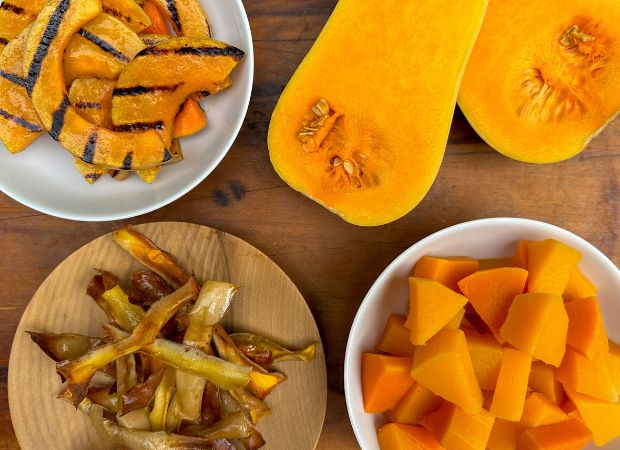When it comes to seasoning and flavour, butternut squash is super versatile. From fresh thyme to miso to tahini to bacon – just about anything goes with butternut.
Butternut’s versatility doesn’t end there, it can also be cooked easily in several ways, so it’s important to choose the method that fits your style and desired outcome to make sure you get the most from your butternut!
While the flesh of the butternut is the most popular part of the squash to eat, you can actually eat the whole butternut – skin and seeds included! You can make ‘crisps’ from the skin peels or with some cooking methods like roasting, air frying, grilling or braaiing, you can cook the butternut without even peeling the skin off.
RECIPE: Roasted butternut hummus with butternut “crisps”
The seeds can be enjoyed the same as you would pumpkin seeds. Clean the butternut seeds so there are no strings or pulp attached and then pat dry with kitchen paper or towel. Line a baking sheet with baking paper and spread the seeds out to form a single layer. Then drizzle over olive oil, season with salt and flavourings of choice and roast at 200°C for about 10 minutes or until they are crisp and nicely golden.
Boil
Boiling butternut is a great way to soften it up and get it cooked through fast. While this method is great if you’re looking for an oil-free cooking method, it is important to keep in mind that boiling is also the least flavourful method for cooking butternut. The flavour profile is quite subdued, especially when compared to the other cooking methods.
The butternut also tends to get mushy and waterlogged if overcooked while boiling, which can affect the texture and overall nutritional value of the squash.
So, it’s best to use this technique when you’re planning to mash or purée the squash, but don’t forget to mix it with an assortment of other flavourful ingredients for the best results. Butternut can also be boiled in stock or added directly to stews or curries to up the flavour.
Steam
Steaming butternut over a pot of boiling water or in a steamer is great for when you don’t have a lot of oven space, are looking for an oil-free cooking method or are just looking to cook up a batch of butternut in a hurry!
The squash also retains most of its nutrients when it is steamed and has a wonderfully sweet butternuttiness to it. Steamed butternut can also be used in a variety of ways – added to salads, mashed, puréed or enjoyed as is with a simple seasoning of your choice.
Microwave
Most like the steaming method, this method doesn’t add much additional water in the cooking process and it too is great if you’re looking for an oil-free cooking method. The flavour profile is sweet and the characteristic butternutty flavour identical to the steamed version.
If you’re looking to make butternut gnocchi or use it to enrich baked goods, this is the method to use because it doesn’t add any unnecessary liquid to the batter or dough.
It’s also a good method to use when you’re in a hurry and need butternut on the table fast! Or try par-cooking butternut pieces in the microwave before marinating and finishing them off in the oven – you won’t be disappointed.
Roast
This is the MVP method when it comes to cooking butternut because not only does roasting cook the squash, but it also helps it to caramelise beautifully. And where food is concerned, remember colour always means flavour!
When it comes to roasting, you can spice and flavour butternut any which way you like, but don’t skimp on oil or salt! Drizzling over enough oil and seasoning liberally with salt is the best way to achieve crisp and golden butternut that is packed with flavour.
When roasting, the butternut does tend to shrink down quite a bit, but from a flavour perspective it has a real butternutty depth to it, with wonderfully sweet notes. This method is also well suited to butternut that has not been peeled, as the skin gets beautifully crisp and golden in the same way as the flesh does.
Air fry
Very similar to roasting, you get the same desired caramelisation as roasting. The butternut can however tend to get a little charred if the pieces aren’t diced small enough and always be sure to give the basket a shake once during air frying, to ensure even cooking.
Unless you use an air-fryer liner to line your basket, the butternut pieces tend to be slightly dryer when compared to roasting, as the squash pieces don’t actually sit in the oil or roasting juices as they cook.
The flavour profile is very similar to the roasted version – each bite has a wonderful depth to it, allowing the sweet, caramelised butternut notes to sing.
As with roasting, the butternut also tends to shrink down when air frying and you can air fry skin-on butternut for crisp, golden and delicious results, just be mindful that the butternut might require a longer cooking time.
Braai/grill
Between the caramelisation from the grill and the smokey hues from the braai, these two methods are sure to impress. Both methods are well suited to skin-on butternut slices.
If you’re planning to go low and slow on the braai, a chunky-cut butternut that has been halved or quartered will produce a wonderfully tender and slightly sweet butternut with a smokey braai feel.
From a flavour perspective, the grill or braai produces butternut that is earthy and more savoury. The sweet notes are far more subtle, allowing the smokey notes to really highlight butternut’s earthy savouriness.

